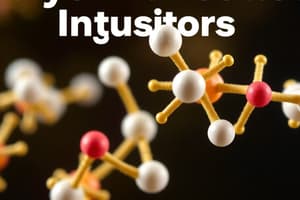Podcast
Questions and Answers
What is the primary mechanism of action for anticholinesterases?
What is the primary mechanism of action for anticholinesterases?
- Increasing acetylcholine synthesis
- Blocking sodium channels
- Inhibiting acetylcholinesterase enzyme (correct)
- Stimulating acetylcholine receptors directly
Which condition is NOT typically treated with reversible anticholinesterases?
Which condition is NOT typically treated with reversible anticholinesterases?
- Myasthenia gravis
- Alzheimer’s disease
- Parkinson’s disease (correct)
- Atropine poisoning
What is a common adverse effect associated with cholinomimetic drugs?
What is a common adverse effect associated with cholinomimetic drugs?
- Urinary retention
- Bradycardia (correct)
- Dry mouth
- Mydriasis
Which of the following describes the action of organophosphorus compounds in poisoning?
Which of the following describes the action of organophosphorus compounds in poisoning?
Why is atropine used in the management of organophosphorus poisoning?
Why is atropine used in the management of organophosphorus poisoning?
What is the primary action of atropine in the management of organophosphate poisoning?
What is the primary action of atropine in the management of organophosphate poisoning?
Which of the following symptoms is NOT associated with muscarinic toxicity from organophosphate poisoning?
Which of the following symptoms is NOT associated with muscarinic toxicity from organophosphate poisoning?
What is the 'golden period' for effective reactivation of acetylcholinesterase after organophosphate exposure?
What is the 'golden period' for effective reactivation of acetylcholinesterase after organophosphate exposure?
Which of the following effects is associated with central nervous system (CNS) toxicity from organophosphate poisoning?
Which of the following effects is associated with central nervous system (CNS) toxicity from organophosphate poisoning?
What is the primary role of oximes in the treatment of organophosphate poisoning?
What is the primary role of oximes in the treatment of organophosphate poisoning?
What is the primary origin of Physostigmine?
What is the primary origin of Physostigmine?
Which drug is characterized as a quaternary amine?
Which drug is characterized as a quaternary amine?
What condition is primarily treated with Neostigmine?
What condition is primarily treated with Neostigmine?
Which cholinomimetic drug is indicated for atropine poisoning?
Which cholinomimetic drug is indicated for atropine poisoning?
Which of the following side effects is associated with cholinomimetics?
Which of the following side effects is associated with cholinomimetics?
What is the action of organophosphates when they bind to AchE?
What is the action of organophosphates when they bind to AchE?
What is a common use of Edrophonium?
What is a common use of Edrophonium?
Which drug is lipid-soluble and can enter the CNS?
Which drug is lipid-soluble and can enter the CNS?
Which of the following is less likely to cause convulsions even at high doses?
Which of the following is less likely to cause convulsions even at high doses?
Which of the following functions primarily distinguishes Physostigmine from other drugs?
Which of the following functions primarily distinguishes Physostigmine from other drugs?
Flashcards
How do anticholinesterases work?
How do anticholinesterases work?
Anticholinesterases inhibit the enzyme acetylcholinesterase (AChE), which breaks down acetylcholine (ACh). By preventing the breakdown of ACh, anticholinesterases prolong the action of ACh at cholinergic synapses.
What is a reversible anticholinesterase?
What is a reversible anticholinesterase?
Reversible anticholinesterases are structurally similar to ACh and bind to the active site of AChE, temporarily inhibiting its activity.
What are organophosphorus compounds (OPs)?
What are organophosphorus compounds (OPs)?
Organophosphorus compounds (OPs) are potent irreversible inhibitors of AChE. They form a stable covalent bond with the enzyme, leading to long-lasting inhibition.
Why is atropine used in OP poisoning?
Why is atropine used in OP poisoning?
Signup and view all the flashcards
What are the main drug classes used in glaucoma?
What are the main drug classes used in glaucoma?
Signup and view all the flashcards
Physostigmine
Physostigmine
Signup and view all the flashcards
Neostigmine
Neostigmine
Signup and view all the flashcards
Cholinomimetic
Cholinomimetic
Signup and view all the flashcards
Anticholinesterase
Anticholinesterase
Signup and view all the flashcards
Aging of organophosphates
Aging of organophosphates
Signup and view all the flashcards
SLUDGE syndrome
SLUDGE syndrome
Signup and view all the flashcards
Cholinesterase inhibitors for Alzheimer's
Cholinesterase inhibitors for Alzheimer's
Signup and view all the flashcards
Physostigmine vs. Neostigmine for atropine poisoning
Physostigmine vs. Neostigmine for atropine poisoning
Signup and view all the flashcards
Organophosphates as insecticides
Organophosphates as insecticides
Signup and view all the flashcards
Edrophonium for myasthenia diagnosis
Edrophonium for myasthenia diagnosis
Signup and view all the flashcards
What is the DUMBBELLS syndrome?
What is the DUMBBELLS syndrome?
Signup and view all the flashcards
What are the nicotinic effects of organophosphate poisoning?
What are the nicotinic effects of organophosphate poisoning?
Signup and view all the flashcards
What are oximes, and why are they used in organophosphate poisoning?
What are oximes, and why are they used in organophosphate poisoning?
Signup and view all the flashcards
Why is atropine used in organophosphate poisoning?
Why is atropine used in organophosphate poisoning?
Signup and view all the flashcards
Study Notes
Anticholinesterase Mechanism of Action
- Anticholinesterases inhibit acetylcholinesterase (AChE).
- This prevents the metabolism of acetylcholine (ACh).
- Prolonging ACh action at cholinergic nerve endings.
- This leads to accumulation of ACh in the synaptic space.
- Reversible anticholinesterases are structurally similar to ACh.
- They bind to AChE sites and inhibit its activity temporarily.
- Inhibitors indirectly promote cholinergic activity by prolonging ACh duration.
Physostigmine vs. Neostigmine
-
Physostigmine:
- Natural alkaloid.
- Tertiary amine.
- Highly lipid-soluble.
- Penetrates the blood-brain barrier.
- Used in glaucoma and atropine poisoning.
- Can cause convulsions at high doses.
-
Neostigmine (and Pyridostigmine):
- Synthetic derivative.
- Quaternary amine.
- Less lipid-soluble.
- Does not readily cross the blood-brain barrier.
- Used in myasthenia gravis, post-operative reversal of muscle relaxation, and atony of the bladder.
- Less likely to induce convulsions than physostigmine.
Therapeutic Uses of Reversible Anticholinesterases
- Alzheimer's disease:
- Galantamine
- Tacrine
- Donepezil
- Rivastigmine
Organophosphate Poisoning & Management
-
Initial treatment:
- Rapid Decontamination
- Maintain Respiration
- Suction of bronchial secretions
- Maintain intravenous line
- Catheterize the urinary bladder
- Control convulsions.
-
Drugs:
- Atropine: Antimuscarinic agent, blocks ACh actions on muscarinic receptors in both central and peripheral nervous systems.
- Oximes (e.g., pralidoxime, obidoxime): Cholinesterase reactivators, given within 2 hours after exposure to reactivate inhibited acetylcholinesterase.
Adverse Effects of Cholinergic Drugs
- Salivation, lacrimation, urination, diaphoresis (sweating), and defecation.
- Gastrointestinal upset (e.g., nausea, vomiting).
- CNS stimulation.
- Miosis (constriction of pupils).
- Bronchoconstriction and tracheobronchial secretions.
- AV block (atrioventricular block).
Drugs Used in Glaucoma
- Parasympathetic agents (e.g., pilocarpine, physostigmine).
- Adrenergic agonists (e.g., dipivefrin, apraclonidine, brimonidine).
- Beta blockers (e.g., timolol, levobunolol, carteolol).
- Carbonic anhydrase inhibitors (e.g., acetazolamide, dorzolamide).
- Prostaglandin analogs (e.g., latanoprost, travoprost).
- Osmotic agents (e.g., mannitol, glycerin).
Studying That Suits You
Use AI to generate personalized quizzes and flashcards to suit your learning preferences.




